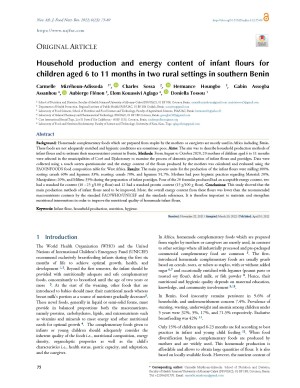Household production and energy content of infant flours for children aged 6 to 11 months in two rural settings in southern Benin
Abstract
Background: Homemade complementary foods which are prepared from staples by the mothers or caregivers are mostly used in Africa including Benin. These foods are not adequately enriched and hygienic conditions are sometimes poor. Aims: The aim was to describe household production methods of infant flours and to estimate their macronutrient content in Benin. Methods: From August to October 2020, 20 mothers of children aged 6 to 11 months were selected in the municipalities of Covè and Djakotomey to examine the process of domestic production of infant flours and porridges. Data were collected using a touch screen questionnaire and the energy content of the flours produced by the mothers was calculated and evaluated using the FAO/INFOODS food composition table for West Africa. Results: The main process units for the production of the infant flours were milling:100%, sorting: cereals 60% and legumes: 33%, roasting: cereals 70%, and legumes: 91.7%. Mothers had poor hygienic practices regarding Material: 20%, Manipulator: 20%, and Milieu: 35% during the preparation of infant porridges. Four of the 20 formulas produced had an acceptable energy content, two had a standard fat content (10 - 25 g/100 g flour) and 12 had a standard protein content (15 g/100 g flour). Conclusions: This study showed that the main production methods of infant flours need to be improved. More, the overall energy content from these flours was lower than the recommended macronutrients contents by the standard FAO/WHO/UNICEF and the standards references. It is therefore important to maintain and strengthen nutritional interventions in order to improve the nutritional quality of homemade infant flours.
Full text article
Authors
Copyright (c) 2022 Carmelle Mizéhoun-Adissoda, Charles Sossa, Hermance Houngbo, Gabin Assogba Assanhou, Aubierge Flénon, Elom Kouassivi Aglago, Doniella Tossou

This work is licensed under a Creative Commons Attribution 4.0 International License.
-
Attribution — You must give appropriate credit, provide a link to the license, and indicate if changes were made. You may do so in any reasonable manner, but not in any way that suggests the licensor endorses you or your use.
-
No additional restrictions — You may not apply legal terms or technological measures that legally restrict others from doing anything the license permits.





